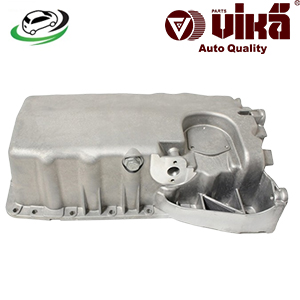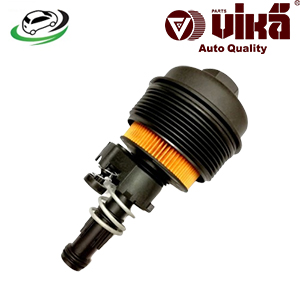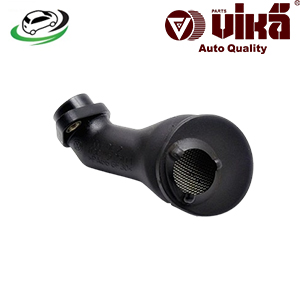-25%
Get Oil sump strainer pipe A1 (8X1/8XK)/ A3 (8P1)/ A1 Sportback (8XA/8XF)/ A3 Sportback (8PA) / VW Jetta III (1K2)/ Golf VI (5K1)/ Passat B7 (362) 03C115251M
The oil sump strainer pipe, also known as the oil pickup tube or oil pickup pipe, is a critical component of an internal combustion engine’s lubrication system. It plays a vital role in ensuring that engine oil is properly circulated throughout the engine, maintaining lubrication, cooling, and cleaning of the engine’s moving parts.
1. Design and Structure
The oil sump strainer pipe is usually made of metal, often steel or aluminum, due to the need for durability and resistance to heat. The design of this component is relatively simple yet crucial in its function.
Key Features of the Oil Sump Strainer Pipe:
- Strainer/Screen: At the inlet of the pipe, there is a strainer or mesh screen that filters out debris, contaminants, and larger particles from the oil before it enters the lubrication system. This is essential for preventing engine damage caused by metal shavings, dirt, or sludge.
- Pipe or Tube: The strainer is attached to a tube or pipe that extends into the oil sump (or oil pan). This tube draws oil from the pan and delivers it to the oil pump.
- Mounting Bracket: The pipe is typically attached to the engine block or oil pump using a mounting bracket or flange, ensuring that it remains securely in place even under the stress of engine operation.
The length and shape of the oil pickup tube vary depending on the engine design, but it is always positioned to reach the lowest point of the oil pan to ensure that oil is available to the pump under all operating conditions.
2. Functionality
The oil sump strainer pipe’s primary function is to ensure that engine oil is continuously supplied to the oil pump. The oil pump, in turn, circulates the oil throughout the engine to lubricate moving parts, prevent wear, and dissipate heat.
How the Oil Sump Strainer Pipe Works:
- Oil Pickup: As the engine operates, oil collects in the sump (oil pan) after being circulated through the engine. The oil sump strainer pipe is submerged in this oil reservoir.
- Filtration: Before oil enters the pipe, it passes through the strainer or screen, which removes larger particles that could damage the oil pump or clog the lubrication system. This step is crucial for maintaining the cleanliness and efficiency of the oil as it recirculates through the engine.
- Oil Delivery to Pump: Once filtered, the oil is drawn up through the tube by the oil pump. The pump then pressurizes the oil and sends it through the oil galleries to various engine components, such as the crankshaft, camshaft, and valve train.
- Continuous Operation: The process is continuous as long as the engine is running. The oil sump strainer pipe ensures that the oil pump always has access to oil, even during rapid acceleration, sharp turns, or on inclines where the oil level might shift within the pan.
3. Materials and Manufacturing
The oil sump strainer pipe is typically constructed from materials that can withstand the harsh conditions inside an engine, including high temperatures, pressure, and exposure to contaminants.
- Steel: Steel is commonly used due to its strength and durability. It is resistant to warping and breaking, which is important given the engine’s vibrations and the pressure fluctuations within the oil system.
- Aluminum: In some high-performance or lightweight applications, aluminum may be used for its lighter weight and good thermal conductivity. However, aluminum is more susceptible to damage from debris or extreme impacts.
- Mesh Screen: The strainer screen is usually made from fine metal mesh, often stainless steel, which resists corrosion and maintains its integrity over long periods of use.
The manufacturing process typically involves precision welding and machining to ensure that the pipe fits perfectly within the engine’s oil system and that the strainer screen is securely attached.
4. Importance in Engine Operation
The oil sump strainer pipe is vital for the following reasons:
- Engine Protection: By filtering out contaminants before the oil reaches the pump, the strainer pipe prevents damage to the pump and other engine components. This protection is crucial for maintaining engine longevity.
- Lubrication Assurance: The pipe ensures that oil is consistently supplied to the pump, which is essential for continuous lubrication. Without it, the pump could run dry, leading to catastrophic engine failure due to friction and overheating.
- Oil Flow Management: The shape and positioning of the strainer pipe are designed to maintain a steady oil flow even under extreme driving conditions, such as during rapid acceleration, hard braking, or while driving on steep slopes. This prevents oil starvation, which can occur if the pump loses contact with the oil.
5. Common Issues and Maintenance
Despite its durability, the oil sump strainer pipe can encounter several issues over time, particularly if the engine is not well maintained.
- Clogging: The strainer screen can become clogged with sludge, debris, or metal shavings, especially if the engine oil is not changed regularly. A clogged strainer restricts oil flow, which can lead to oil starvation and engine damage.
- Cracks or Leaks: The pipe itself can develop cracks or leaks, particularly if it’s made from lower-quality materials or subjected to extreme conditions. A cracked pipe may allow air into the system, reducing oil pressure and leading to inadequate lubrication.
- Corrosion: In older vehicles, or those operated in harsh environments, the strainer pipe may corrode, especially if it’s made of steel. Corrosion weakens the pipe and can eventually cause it to fail, leading to oil pump problems.
- Damage from Debris: Road debris or internal engine failures (like a broken timing chain) can physically damage the oil sump strainer pipe, leading to blockages or breaks.
Maintenance Tips:
- Regular Oil Changes: The most effective way to prevent issues with the oil sump strainer pipe is by performing regular oil changes. Fresh oil is less likely to carry contaminants that can clog the strainer.
- Engine Inspections: Periodic inspections of the oil pan and strainer pipe, especially during routine maintenance or when the oil pan is removed, can help catch potential issues before they become serious.
- Use of Quality Oil: Using high-quality engine oil that meets the manufacturer’s specifications can reduce the risk of sludge and debris buildup, which protects the strainer pipe and the entire lubrication system.
6. Replacement and Repair
Replacing or repairing the oil sump strainer pipe typically involves removing the oil pan to gain access to the pipe. This procedure is generally straightforward but requires care to avoid damaging the pipe or strainer.
Steps for Replacement:
- Drain the Oil: The engine oil must be drained before the oil pan can be removed. This prevents spillage and makes it easier to see and access the strainer pipe.
- Remove the Oil Pan: Once the oil is drained, the oil pan is unbolted and removed, exposing the oil sump strainer pipe.
- Inspect the Pipe: The strainer pipe is inspected for any signs of damage, clogging, or wear. If the screen is clogged, it might be cleaned, but if the pipe is damaged, it usually requires replacement.
- Install New Pipe: If replacement is needed, the old pipe is removed and a new one is installed, ensuring a tight fit and secure mounting to prevent leaks or dislodgement.
- Reinstall the Oil Pan: After the new pipe is installed, the oil pan is reattached with a new gasket to ensure a proper seal, and the engine is refilled with oil.
7. Performance and Aftermarket Considerations
In high-performance engines or off-road vehicles, upgrading the oil sump strainer pipe can be beneficial. Aftermarket options may include reinforced pipes, larger diameter tubes for improved oil flow, or more advanced strainer screens that offer better filtration.
Performance Benefits:
- Improved Oil Flow: A larger or smoother pipe can enhance oil flow, ensuring that the engine receives adequate lubrication even under extreme conditions.
- Enhanced Durability: Aftermarket pipes made from higher-grade materials can withstand more stress and last longer than standard OEM parts.
- Better Filtration: Advanced strainer screens can capture smaller particles, providing better protection for the engine and extending its life.
Follow us on Facebook for more parts.



